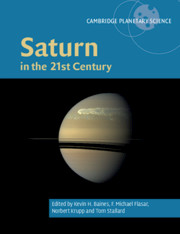Book contents
- Saturn in the 21st Century
- Cambridge Planetary Science
- Saturn in the 21st Century
- Copyright page
- Contents
- Contributors
- Reviewers
- 1 Introduction to Saturn in the 21st Century
- 2 The Origin and Evolution of Saturn, with Exoplanet Perspective
- 3 The Interior of Saturn
- 4 Saturn’s Magnetic Field and Dynamo
- 5 The Mysterious Periodicities of Saturn
- 6 Global Configuration and Seasonal Variations of Saturn’s Magnetosphere
- 7 Saturn’s Aurorae
- 8 Saturn’s Ionosphere
- 9 Saturn’s Variable Thermosphere
- 10 Saturn’s Seasonally Changing Atmosphere
- 11 The Global Atmospheric Circulation of Saturn
- 12 Saturn’s Polar Atmosphere
- 13 The Great Saturn Storm of 2010–2011
- 14 The Future Exploration of Saturn
- Index
- References
14 - The Future Exploration of Saturn
Published online by Cambridge University Press: 13 December 2018
- Saturn in the 21st Century
- Cambridge Planetary Science
- Saturn in the 21st Century
- Copyright page
- Contents
- Contributors
- Reviewers
- 1 Introduction to Saturn in the 21st Century
- 2 The Origin and Evolution of Saturn, with Exoplanet Perspective
- 3 The Interior of Saturn
- 4 Saturn’s Magnetic Field and Dynamo
- 5 The Mysterious Periodicities of Saturn
- 6 Global Configuration and Seasonal Variations of Saturn’s Magnetosphere
- 7 Saturn’s Aurorae
- 8 Saturn’s Ionosphere
- 9 Saturn’s Variable Thermosphere
- 10 Saturn’s Seasonally Changing Atmosphere
- 11 The Global Atmospheric Circulation of Saturn
- 12 Saturn’s Polar Atmosphere
- 13 The Great Saturn Storm of 2010–2011
- 14 The Future Exploration of Saturn
- Index
- References
Summary
Despite the lack of another Flagship-class mission such as Cassini–Huygens, prospects for the future exploration of Saturn are nevertheless encouraging. Both NASA and the European Space Agency (ESA) are exploring the possibilities of focused interplanetary missions (1) to drop one or more in situ atmospheric entry probes into Saturn and (2) to explore the satellites Titan and Enceladus, which would provide opportunities for both in situ investigations of Saturn’s magnetosphere and detailed remote-sensing observations of Saturn’s atmosphere. Additionally, a new generation of powerful Earth-based and near-Earth telescopes with advanced instrumentation spanning the ultraviolet to the far-infrared promise to provide systematic observations of Saturn’s seasonally changing composition and thermal structure, cloud structures and wind fields. Finally, new advances in amateur telescopic observations brought on largely by the availability of low-cost, powerful computers, low-noise, large-format cameras, and attendant sophisticated software promise to provide regular, longterm observations of Saturn in remarkable detail.
- Type
- Chapter
- Information
- Saturn in the 21st Century , pp. 417 - 441Publisher: Cambridge University PressPrint publication year: 2018



